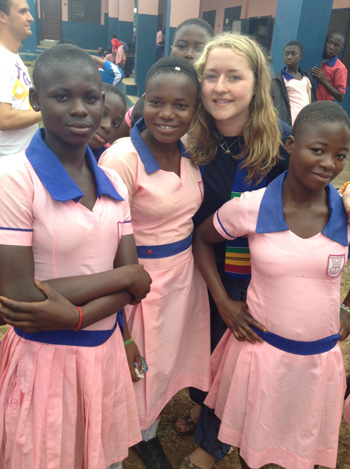The Colour of Culture by Sophie Wilbraham

There is something intoxicating about a country where its people are as bright as the colours it is associated with.
Since my trip to Ghana, Africa earlier this summer I have realised there is no mystery as to why we associate Africa as being such a colourful continent. ‘TIA bruh,’ people would say- ‘This is Africa.’ And that was that. It was the explanation for everything surrounding anything spontaneous and accepted without question as the perfect summary for Ghanaian life. In fact, I would put colour as the perfect metaphor for Ghana as a whole; its boldness, evidence of the pride its people have of being Ghanaian: and in particular for the women I was inspired to have met. Immediately I noticed the subtlety of what I saw as captivating self-confidence simply within the way women carried themselves with such beautiful pride.
We had arrived by bus at Dreamland International School, Akumadan in the Ashanti region of Ghana where we would spend the next 10 days. The group of us were unprepared for our welcome: a fantastically loud and grinning mob of at least fifty children streaming from all corners of the school, pulling us in every direction with such enthusiasm at that moment I don’t think I would have cared if one of them had pulled my arm right off.
Because of the eagerness of our initial little reception (which of course was followed by every question they could think of including, not settling at just asking my name, but also every member of my family, all of my friends and indeed one-time acquaintances) it wasn’t until the second day when I first properly encountered one of the female teachers at the school. She was in her early 20s and I had been dragged over to her by Constance, a little girl of 12 years old who had told me she thought that this Madame was the most wonderful person in the world. She introduced herself as a teacher of English and Mathematics and very quickly I got to know the qualities of kindness and passion she had towards her job and particularly her pupils. I remember being struck by the pure selflessness of her character. This was a young woman amongst a culture where she was naturally considered ‘inferior’ by its majority, in a life without materialistic luxury, paid barely enough to live on: yet who had more life and colour in her than the best of us could ever hope for.
I hate to hear when someone from a third world country is described with ‘little to their name.’ I can tell you that in most cases they are fifty times more genuine: and that seems to me to be something significant to have claim to. I think often about a conversation I had with another group of girls, all my age at 17 years old. We happened to talk about shoes because they had commented on my sandals. I was wearing a pair of my Dad’s long rugby shorts as we had been advised to be respectable in our clothing. Stood with the others I felt exceptionally boring next to their typically technicolour spectrum of dresses and bubbly personalities. One asked me in a heavy Ghanaian accent:
‘Why you wear this?’ She cast a hand disapprovingly towards my shorts and I explained this is what we wore in England in the summer.
They tutted collectively and another girl answered my puzzled expression:
‘In Ghana if you wear this you are a prostitute, or you are raped.’
This was the first culture shock of many that answered too many of the questions I hadn’t even thought to ask.
This was normality for these teenage girls. Wear shorts above the knee and you will be raped.
This was the reality: their society was coloured with dark aspects of life that they couldn’t avoid despite all the beauty of their natural and vivid optimism.
And yet alongside all of the inhumanity and the injustice, the strong influence of so many of the characters I met (and wish I had met) was so present in Ghanaian culture within the clothing, the markets, the landscape, and most importantly within the nature of their strength, courage and love. Greens, reds, yellows, blues and oranges- these are the kind of colours that say: Look around! Life is there to embrace!
Inspiring, when you think about it.

Comments